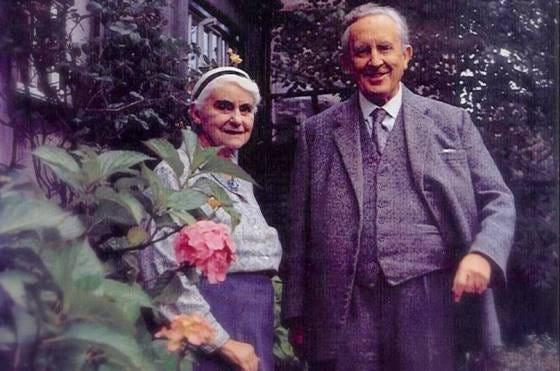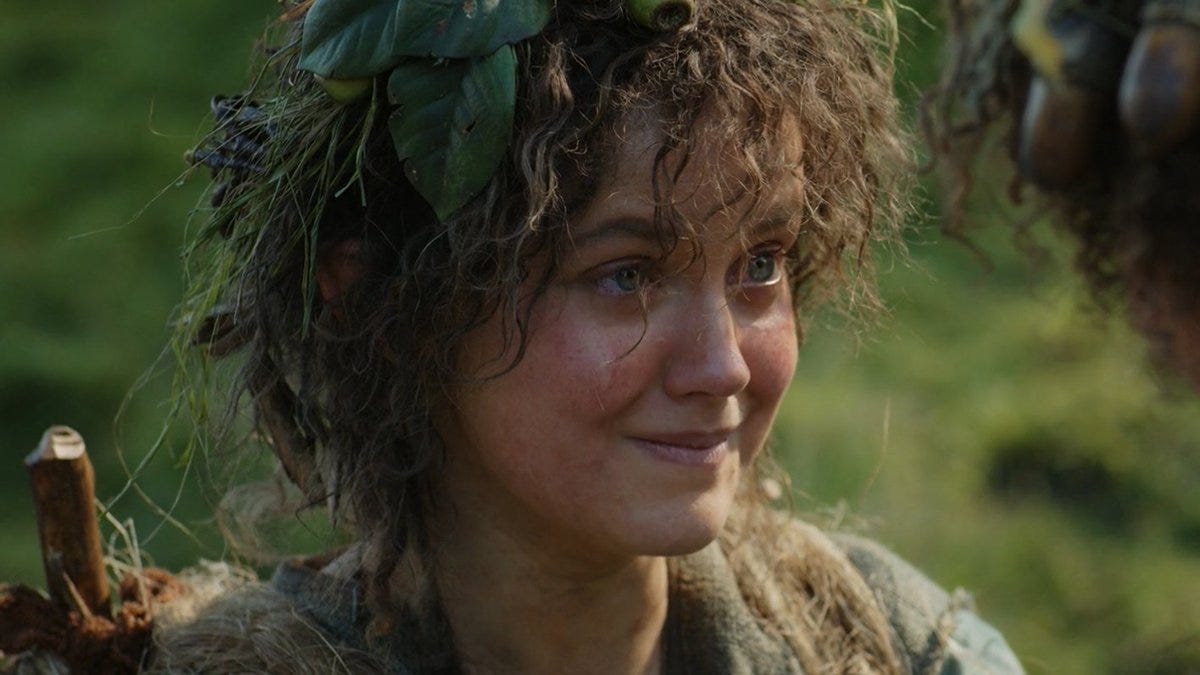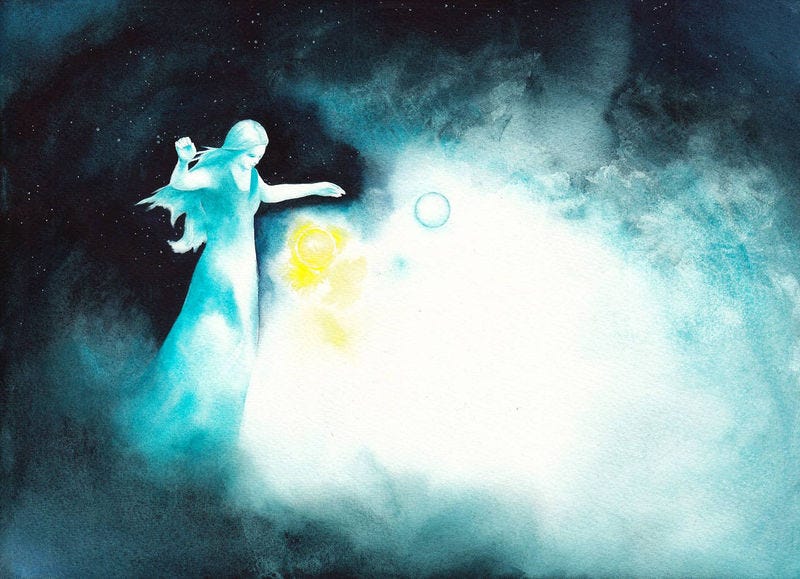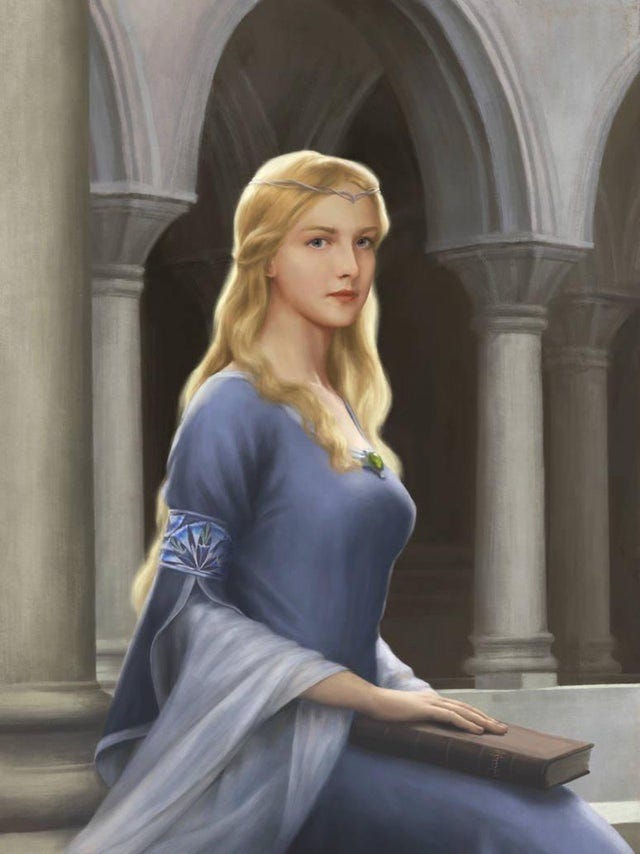Queens Most Womanly, but Queens of Men
An introduction to some of the mighty women of Tolkien's Legendarium

Author’s note: This isn’t exactly a new essay, I initially wrote this back last year for International Women’s Day. Well, “wrote” is a bit generous; I was a new Tolkien writer trying to hard to make a mark, so to try and capitalize on the day I banged this out in unseemly haste. And ironically, I wasn’t even ready to release this on the day, publishing it the day afterwards instead. The first version of this piece showed all the marks of something written in haste by somebody who thought he knew more than he actually did. Well, now I am correcting my haste. Here is that article again, but with more care taken and my much improved scope of Tolkien knowledge employed to good effect. I am much happier with this version.
While J.R.R. Tolkien was not exactly a fan of The Ballad of the White Horse, the poem from which this essay’s title is taken (in Letter 80 he says “The ending is absurd. The brilliant smash and glitter of the words and phrases (when they come off, and are not mere loud colors) cannot disguise the fact that G. K. C. knew nothing whatever about the ‘North’, heathen or Christian”) he would have wholeheartedly shared the devotion to the Virgin Mary that inspired Chesterton to describe her in these terms. As devout a Catholic as Chesterton, he translated the Hail Mary into Elvish, and in a letter to his friend Father Robert Murray he calls Mary the person “upon which all my own small perception of beauty both in majesty and simplicity is founded.” But even without his faith, he would probably have found much to love about the Virgin Mary, for strong, noble, and inspirational women played a huge role in many aspects of his life and helped shape the person and author we know and love. The impact of his mother Mabel upon him was huge; she outlived her husband, sacrificed so much to insure that John Ronald Ruel and his brother Hilary were well-educated and happy, was influential regarding Tolkien’s relatively enlightened views on race (as per his biographer Humphrey Carpenter, Mabel had no patience for racism during her time living in South Africa, and this could not have failed to have an impact) encouraged Tolkien in his burgeoning interest in writing and art, and led them both to the Catholic faith; Tolkien would revere her as a “white martyr” for sacrificing so much for him and his brother. He had a wonderful aunt on his father’s side, also called Mabel, who told him magnificent stories about the storied history of the Tolkien family which were epic, even if they might not always been the most consistent. No telling of Tolkien’s life story is complete without mentioning his courtship and marriage to Edith, their life together, how a scene from their honeymoon inspired one of the most romantic scenes in the legendarium, and how he devoted his retirement to giving her the best life possible. He loved his only daughter Priscilla, and his “unauthorized” biographer David Grotta speculates that some of his heroines from the legendarium exist in large measure to provide Priscilla with inspirational and relatable role models. And in contrast to his fellow Inkling and best friend C.S. Lewis, who half-jokingly but kinda sorta seriously believed that female academics should hang up their robes and return to the kitchen, Tolkien was strongly supportive of female academics, both his peers as Oxford professor and the promising up-and-comers he taught.
This reverence for women can be found throughout the pages of Tolkien’s lore. Far from the stereotype of a patriarchal world, loved by some and hated by others, Arda is a place where some of the greatest and most inspirational characters are women. So on this International Women’s Day of the Year of Our Lord 2024, here are some of them, and only some of them. As heroic archetypes, as mothers, warriors, lovers, strategists, mentors and healers, there is no shortage of heroic and inspirational characters. These are merely the the ones whom I find personally to be the most inspiring, the most reassuring and comforting, the most exciting, and the most heroic.
Varda
We first meet Varda in a song, a hymn to Elbereth (her Sindarin name) sung by a wandering company of Elves traversing the Shire to get to the Grey Havens. Even in song, her name has power; a Black Rider who is getting uncomfortably close to Frodo, Sam and Pippin turns and flees in the opposite direction. And this is only a taste of the power of Varda Elentari: the Queen of the Stars, the spouse of Manwe, one of the three mightiest of all the Valar, and the one whom Morgoth hated and feared above all others. For Varda could see farther than all other eyes and could pierce the darkest glooms, and she had a special care for light which Morgoth could not control. It was she who created the stars as a challenge to evil that no shadow could touch, and it was she who, when Morgoth destroyed the Two Trees of Valinor, took their last fruits and created the Sun and Moon. It was the light of the stars that the Elves first saw when they awoke in the Elder Days, and to Varda they have ever called in time of need. And they would not be the only ones. Even in the pits of Shelob’s lair, even at the gates of the tower of Cirith Ungol, her name has power, as Samwise Gamgee learns when he can turn back Shelob and shatter the vigilance of the Silent Watchers by a tactical combination of her name and the light of Earendil. Truly, Varda is a being of power and grace nearly equal to Mary “whom God kissed in Galilee” even if she is not an exact match.
Galadriel
I’ve never made the mistake of considering Galadriel as a type of Mary in the same way as Varda clearly is. But might surprise long time followers of this blog and its linked socials that I wasn’t always as fond of her as I am now. I always accepted on faith that she was beautiful, strong, wise and noble. But because in the books, especially the Trilogy itself, she always appears less as a character in her own right and more of a vision seen through the eyes of others, my heart tended to be given to other, more real characters. Until Morfydd Clark brought to life the flawed, striving, heroic character of Unfinished Tales and the Letters, with a beating heart, an Amazon disposition, a personal journey, a free spirit, a strong sense of duty and justice, and a love for joy. Now, at last, I understood how Galadriel could inspire people as different as Sam and Faramir, Gimli and Celeborn, and awaken in them all a sense of wonder, awe, beauty, reverence and courtly love (and in the case of Celeborn, romantic love as well). Because, as I’ve written about before and doubtless will continue to do, Galadriel the person awakens these feelings in me as well, in a way that Galadriel the legend simply doesn’t.
Luthien
By 1917, Tolkien had been transferred from the battlefields of France back to England owing to a bad case of trench fever, and he was spending time with Edith. While stationed at Kingston upon Hull, the two of them visited the woods near Roos, and when they entered a grove of hemlock she sang and danced for him. Thus would Tolkien be inspired to write the story of how Luthien Tinuviel, of both elven and divine race with the voice of a nightingale, met the mortal Beren and began the greatest romance in Middle earth’s history. But Luthien is more than just a great love interest, but is a powerful, strong and heroic character of her own. She dared both the wrath of her father and the fear of her mother to do what she felt was right; defeated Sauron himself with no aid except from the mighty wolfhound Huan; penetrated the heart of Morgoth’s Hell on earth with only Beren and charmed the Dark Lord to sleep with her songs; gave up the immortal life of the Elves to be with Beren; and moved Mandos himself, that most forbidding and implacable of all the Valar, to tears pleading for Beren’s life. No wonder Tolkien would reuse the account of their first meeting when writing of Aragorn and Arwen’s meeting, and no wonder he would inscribe “Luthien” on Edith’s tombstone.
Idril
Moles are known as tunneling animals. So it is more than a little ironic to me that when Maeglin of Gondolin, leader of the noble House of the Mole, betrayed the city to Morgoth, at least 800 people would be saved from the sack by…a tunnel, and one Maeglin had no idea existed. For this we can thank Idril Celebrindal, somebody who is only mentioned once in the trilogy but who played a significant role in saving the world in the first age. She is part of the second of only three unions of Elves and Men, when she married the human warrior Tuor and had a son named Earendil. Alone of all the lords and nobles of Gondolin, she foresaw a time when the seven walls and secrecy of the city would fail, and in anticipation of this she had the aforementioned tunnel secretly dug. When catastrophe struck, therefore, she and Tuor were able to lead a remnant of the city to safety And in the 1917 version of this story, she takes an incredibly active role, donning a mail hauberk and wielding a sword to defend Earendil and to hold open the road to the secret way; she may not have been an Amazon like her second cousin Galadriel, but she was no shrinking violet and was perfectly willing and able to do violence in defense of those she loved. And their son Earendil would grow into a mighty sailor, half human and half elf, and thus able to finally appear before the Valar as a representative of both elves and men and appeal for mercy and salvation. Had Idril not dug that tunnel, the tales would have been VERY different.
Nori Brandyfoot

This entry to the list is a bit of an odd one. Nori is not a character whom Tolkien himself came up with. For one thing, had he come up with her he almost certainly would have come up with a different name; Nori is short for Elanor, a name that didn’t come into vogue among Halflings until Sam, after his adventures, named his firstborn daughter that in honor of the golden elanor flowers he saw in Lothlorien. But he could have. Here is a small heroine with “something Tookish” inside her, not in the comic-relief and bumbling sense that we see in the movies right until the scene where Pippin pledges himself to Denethor, but in the selfless, conspiratorial and comradely sense that we see first in “A Conspiracy Unmasked” from The Fellowship of the Ring. Nori has a sense of awe at the wide world around her and a desire to engage with it fully and find joy in it. When a star falls from the heavens, once the initial shock wears off her sole purpose is to help the mysterious and pitiable giant she finds in the impact crater, come what may, even at the risk of ostracism from her Harfoot community. And not just physical aid; she senses intuitively that there is something special about the Stranger, that he is not a peril to himself or others but is in fact good, and works so hard to bring out his potential for goodness. And when she finally does break off from her beloved family and friends in the finale, it is not in a self-centered desire for adventure like how Arya Stark leaves home and family behind in the finale of Game of Thrones, but to stand beside the Stranger as, having finally found his voice, he sets off to find his purpose. And not only to assist the Stranger; leaving also gives Poppy Proudfoot, her best friend, a chance to grow, to find her own place, and become her own person. Nori may be very small, but she has a big heart, big enough for so many people. In the best traditions of Tolkien’s heroine’s that he actually did write.
Eowyn
I don’t think there’s an LOTR fan alive who isn’t familiar at least with Eowyn as we meet her in the Peter Jackson trilogy. A daughter of kings, a shieldmaiden of Rohan, who rides to battle disguised as a man and fulfills a prophesy by striking down the mighty and terrifying Witch-King of Angmar. But there was so much more that Jackson either had to leave out or cover very superficially. How she knew orphanage and grief at a very young age with the loss of both her parents. How she suffered years of emotional abuse from the evil Grima Wormtongue and had to watch her uncle Theoden age literally before her eyes. How when at last the king was saved by Gandalf the White, she fell in love with Aragorn as a young knight will fall for a great captain. How when he sadly had to let her down, she spiraled into essentially suicidal depression. How, despite this, she at 25 and being a woman of one of the races of Middle Men struck down one of the greatest evils of all Third Age Middle earth. How she finally found healing and peace, and not solely in the love of Faramir but also in transcending the sword. “The hands of a king are the hands of a healer” and Eowyn chose to be a healer. She did not diminish herself, but rose in dignity and joy. To have touched the darkness almost to the point of death, but to have vanquished it, is something that has given me a great deal of hope, and I want everyone who hears or sees her story to experience that hope too.
Varda, Galadriel, Luthien, Idril, Nori and Eowyn. It’s a worthy and wonderful company, and the best part is that these are only six people in a long list. Arwen and Haleth, Melian and Tauriel, Miriel and Rosie Cotton, Bronwyn and Aredhel, Yavanna and Morwen…Tolkien was a man, but a true man, in that he respected and loved the power, mystery, beauty and purpose of the fairer sex, independent of men and far from being merely their subordinates. For a man who believed that God humbled himself to the point that He came into the world as a baby born of a Virgin, could he have been anything else? So, on this International Women’s Day and indeed all days, if you see hateful orcs on Youtube and Twitter spewing bile against Morfydd Clark’s Galadriel, or artists reimagining Arwen as some sort of anime waifu, or people insisting that Luthien’s main purpose in the Quest for the Silmaril as being beautiful, or gloating over how Eowyn hung up the sword…do not despair. They cannot conquer forever. The truth has power they cannot comprehend, and the truth is simple: Tolkien loved women, and his legendarium echoes this. It is no “man’s story” with some sort of patriarchal worldview, but a story where both genders can take leadership, can do great and mighty things, and can inspire anyone at all who reads their stories to be the best versions of themselves.








